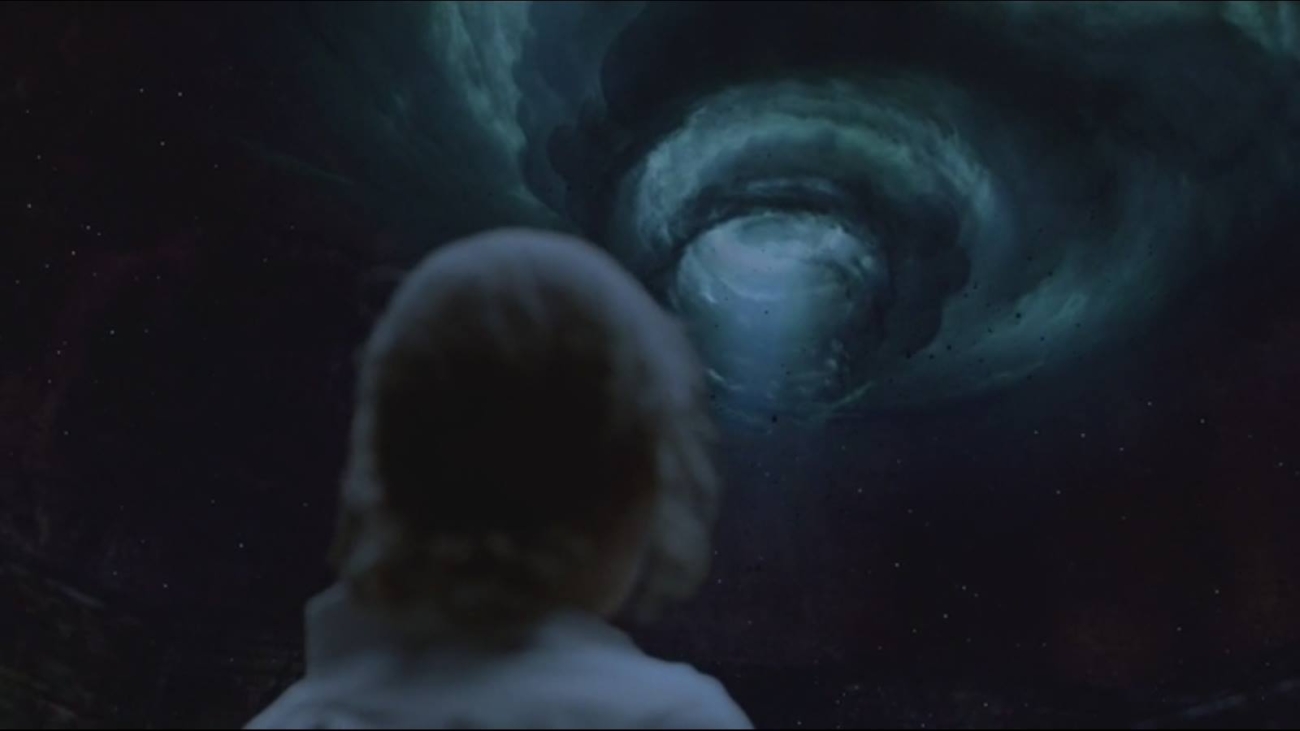A religious rite ought to form a religious community around a common ethos: a set of commonly held values that are both cause and effect of the commonly recognized highest power.
Religious Experience and Ethics
Is there any relationship between religious experience and living a life full of character and conviction?
Why a circular Tree of Life?
Reflections on the Path in Eternity (Part 4)

I came to magick via an unsual path: through my interest in the German philosopher Georg Wilhelm Friedrich Hegel.
Hegel was not a magician. He was a late-18th/early-19th century philosopher in the idealist tradition (a branch of thought taking influence from Descartes, Berkeley, and Hume, but which is usually seen as having its origin with the Prussian philosopher Immanuel Kant).
But it was after I had been interested in Hegel for over a decade that I read Glenn Magee’s book, Hegel and the Hermetic Tradition. (You can read the introduction of the book here for free. It actually provides a pretty good orientation for how Hermetism differs from Gnostism and traditional Christianity.)
Magee persuaded me that Hegel’s philosophy of Absolute Idealism owed at least as much to Renaissance Hermetism (or Hermeticism as it’s sometimes called) as it did to rational thinkers such as Hume or Kant.
Magee understands Hermetism as a broad spiritual current which has a theological basis in the Corpus Hermeticum but which also includes currents such as Qabalah, alchemy, and magic.
Pretty much everything we consider to be the western magical tradition has its origins in Renaissance Hermetism, in particular the synthesis given to it by Cornelius Agrippa. (Really the only component missing from Agrippa’s synthesis is the tarot.)
For more on this I highly recommend Frances Yates’s Giordano Bruno and the Hermetic Tradition. Certain aspects of her work are considered controversial now. I recommend reading Copenhaver, Hanegraaff, and Kingsley alongside her.
One of the main impacts Magee’s book had on me when I read it is that—oddly enough—it legitimized occultism for me.
Hegel was a philosopher I had spent over a decade studying both in and outside of academia. I considered a lot of my philosophical intuitions to be “Hegelian”. The experience was a little bit like having lived in a house for several years and then one day discovering a secret sub-basement that wasn’t on any of the building plans.
I was becoming familiar with the Qabalah right around the time I read Magee’s book (largely due to the work of my friend Daniel Ingram who also legitimized magick for me), so I recognized the Tree of Life in its usual top-to-bottom arrangement. But I was surprised to find out that there had been alternative arrangements of the sephiroth over time, including one in which they were presented as concentric circles.
For instance, Johann Jakob Brucker gave them a circular arrangement in volume 2 of his influential Historia Critica Philosophiae (1742).
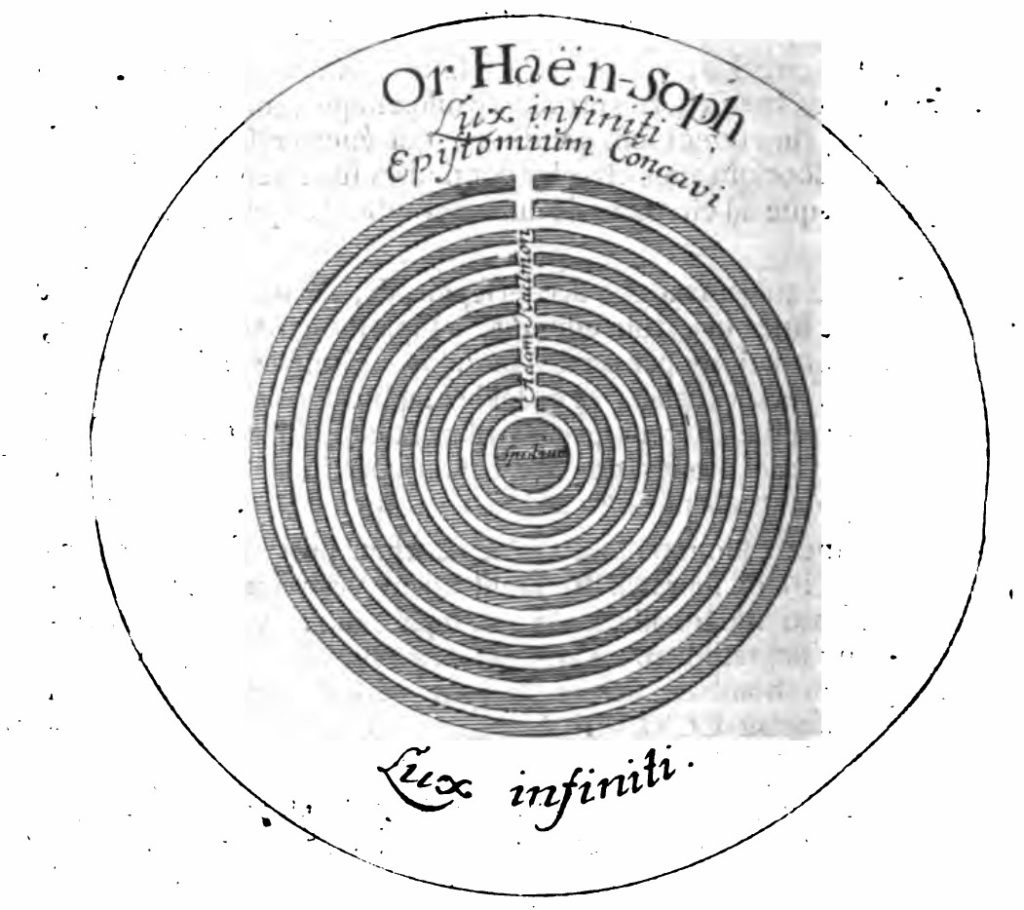
This diagram was Brucker’s attempt to illustrate a concept from the Lurianic tradition of Kabbalah, according to which each new act of creation or manifestation in the world is the result of a simultaneous contraction and expansion.
Isaac Luria and his followers envisioned the Ain Sof—the limitless infinity we previously identified with Nuit—as an infinite sphere in which a smaller sphere of empty space came into being through the tsimtsum, a primordial contraction or withdrawal of God.
It is into this empty space that God injects a ray of light which differentiates itself into the classical ten sephiroth. These were thought of as concentric circles of light filling the space within God created by the primordial contraction.
The first definite being that appears in the wake of the tsimtsum is Adam Kadmon (macroprosopus in the previous post). Adam Kadmon exists above the four worlds and mediates the light of Ain Sof into them.
Adam of the Bible—Adam Ha-Rishon—is an imperfect earthly embodiment of Adam Kadmon. While Adam Kadmon is spirit outside of space and time, Adam Ha-Rishon is spirit developing in nature, from the fall in the Garden of Eden and the loss of the immediate relationship to God, eventually to the recovery of that relationship in religion and mysticism (namely, Kabbalah).
(Ra-Hoor-Khuit is to Chaos as Adam Kadmon is to Adam Ha-Rishon.)
The implication of this concentric arrangement is that the material universe, individuals, and human history are not outside of the divine. Everything is in a certain sense “in” God. It’s just there in a corrupted or fallen state which has to be rectified over time.
This sense of us being in God, of directly participating in the divine all the time whether we know it or not, can be occulted by the traditional top-down arrangement of the sephiroth, where it looks as though Kether, Ain Sof, and Ain are somehow way above us mere earthlings.
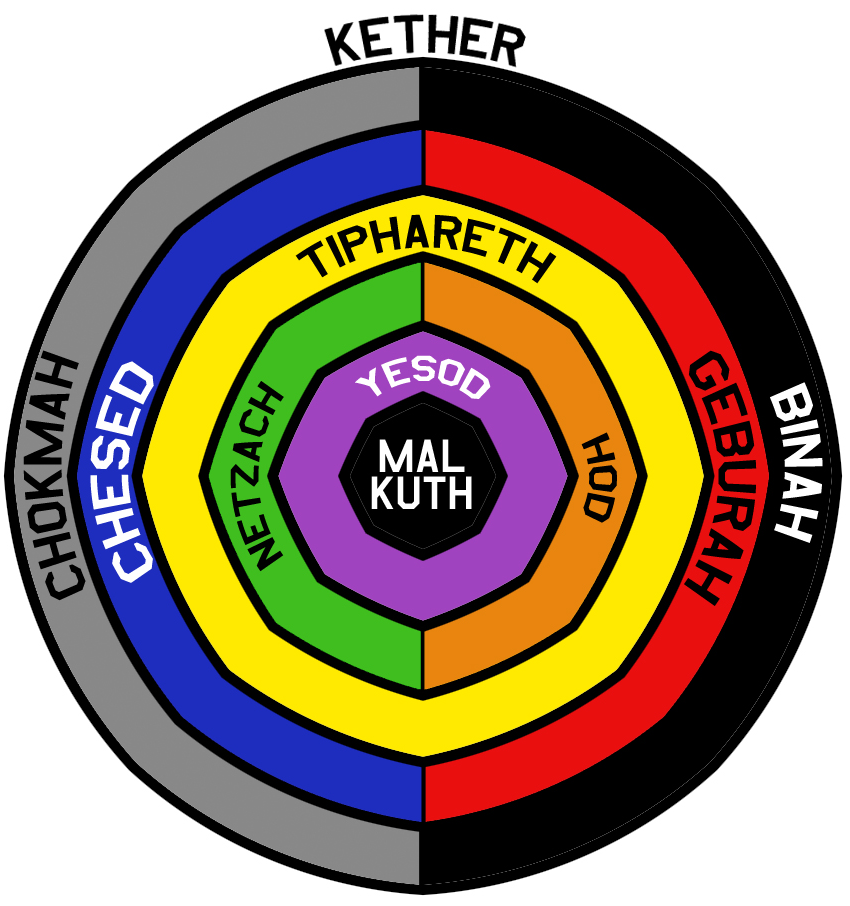
“A View from Kether” by IAO131
A few years later when I got into Thelema, I was pleased to see someone else had taken an interest in a similar arrangement. IAO131 created a diagram similar to Brucker’s in which Kether surrounds and contains the other sephiroth. My own version was inspired by his insofar as the sephiroth on the lateral pillars are depicted as semicircles rather than complete spheres.
What these concentric representations of the Tree of Life share in common is the implication that the reality we find ourselves in is one formed from an overarching, primordial, divine unity which divides itself.
There is some evidence in Crowley’s writings to support this view of our reality being the result of a self-division of God.
To know itself, each such Star, or Soul, must eat of the Fruit of the Tree of Knowledge of Good and Evil, by accepting labour and pain as its portion, and death as its doom. That is, it must reveal its nature to itself by formulating that nature as duality. It must express itself by a series of symbolic gestures ostensibly external to it, just as a painter reveals one facet of his Delight-Diamond by covering a canvas with colours in such a way that the picture seems at first sight to represent something outside himself. It must, in fact, repeat for itself the original Magick of Nuith and Hadith which created it.
New Comment on AL I.29 (emphasis mine)
AL I.29—of which this passage is a commentary—reads, “For I am divided for love’s sake, for the chance of union.”
We find in this passage echoes of the Lurianic idea of the fall as a temporary but necessary tragedy resulting from the diremption of an original, absolute whole (in this case the “Star, or Soul” of the individual).
The way to overcome this division is to repeat for ourselves the “original Magick of Nuith and Hadith” which created the star.
In this passage, Crowley presents the path toward liberation in artistic terms. The task is to see the world and the events in it, not as alien to our desires, but rather as vehicles for the manifestation of them. We are to view matter as (akin to) artistic medium.
The world loses its alien, painful character when it is understood and willed. When we can see the world as our own artistic creation, we have achieved liberation.
This is an interpretation of the Thelemic path of liberation I explored in my talk on the Magical Power of Art.
It was with something like this in mind that I formulated my own version of the concentric Tree of Life. However, unlike Brucker or IAO131, I reversed the order of the sephiroth. Rather than having Kether on the outside and Malkuth in the center, Malkuth is on the outside and Kether is in the center.
As it turns out, my reasons for doing this are numerous and complex. But before explaining any of them in detail, it’s worth mentioning that old adage that “the map is not the territory.”
I don’t believe sephiroth literally exist, let alone whether they are really, in any kind of metaphysical sense, related to one another externally or internally, or whether Malkuth can really be said to be at the center or not. That’s not really the point of a diagram.
In this context, the purpose of the diagram is to serve as a heuristic. It’s an attempt to convey some complex ideas in a simplified format that makes them easier to comprehend.
There could well be certain aspects of Thelema that are better captured by having Kether on the outside and Malkuth in the center, just as there are aspects that are better captured by the usual hierarchical (top-down) arrangement.
All of that being said, there are a lot of spiritual, metaphysical, theological, and soteriological assumptions packed into this simple decision to put Kether at the center and Malkuth on the outside.
Some of them require a lot of explanation and carry with them a lot of implications, so rather than go into any of them in depth right now, I’ll just list them succinctly.
- Repeat = Defeat. Let’s present something familiar in an unfamiliar format to discover new things about it.
- The journey is inward, out outward. Crowley described the work of A∴A∴ (in contrast with the work of O.T.O.) as a process of going inward toward the three supernal sephiroth. Without taking it too literally, that implies a certain spatial relationship. And since all the sephiroth are to be found “in” Malkuth, this links Thelema with what might be termed a chthonic counter-current in Western mysticism.
- The Khabs is in the Khu, not the Khu in the Khabs. Again, this implies a particular spatial relationship. This also implies that divine reality is not some original whole we were cut off from and have to get back to. This core spiritual idea sharply differentiates Thelema from Hegelian Idealism, Gnosticism, or even from Kabbalah. In Thelema the individual really is primary and irreducible in a way that you just don’t find in those other traditions.
- Thelema is about 2, not about 1. It’s all about the relationship between Hadit and Nuit. In order for there to be a love relationship between Hadit and Nuit, Nuit must be other than Hadit. That doesn’t work if Hadit and Nuit are merely parts of a primordial, original whole.
- It’s all about the going. Experience matters. Change is real. It is powerful, it is divine, and it is meaningful. The O.T.O. teaching on the Path in Eternity is as central to Thelema as are the teachings of A∴A∴ on the Holy Guardian Angel and the Abyss.
- It’s magick, not just mysticism. Going implies change, change implies magick, magick implies the Will. Willing implies traditionally masculine qualities such as mastery, overcoming, and expansiveness in addition to the feminine characteristics of dissolution and surrender that are particular to mysticism. Both sides are necessary for a complete understanding of Thelema.
I don’t know yet if I’m going to write posts about all of these. If there are particular ones you definitely want to hear about, though, let me know in a comment.
The Gnostic Mass as a Religious Rite
When interpreting the Mass, it’s important to keep in mind that it’s a religious rite, and so it’s not possible to capture the main idea behind it simply with categories that apply to magic(k), mysticism, or the mysteries of OTO.
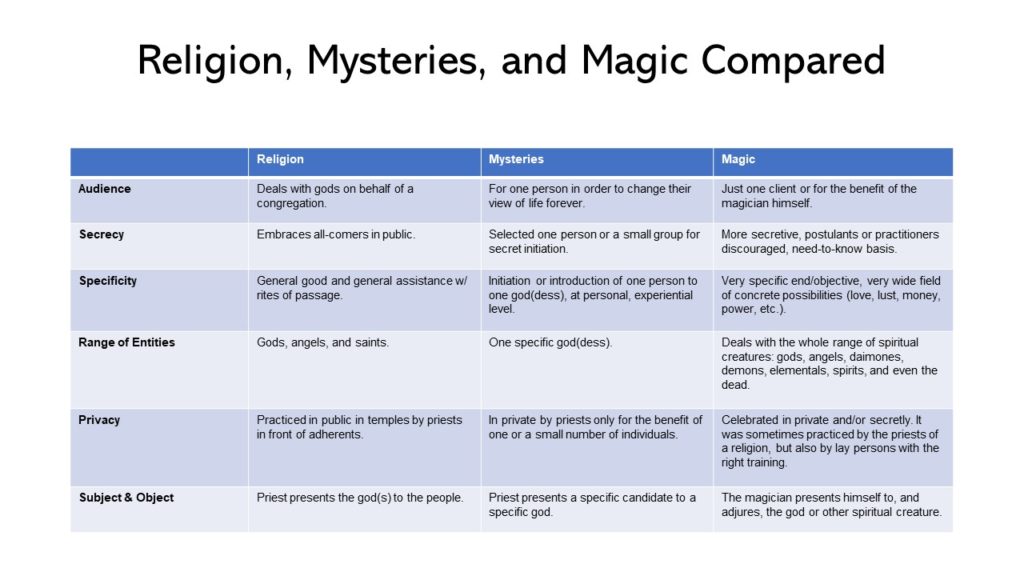
This is a slide from my Minerval lecture summarizing Stephen Skinner’s treatment of these categories in Introduction to Techniques of Graeco-Egyptian Magic. I use this to show what is distinctive about initiation into a mystery school (such as M∴M∴M∴) versus attending Mass or doing private ritual at home. But it’s also useful for seeing what is distinctive about the Mass as a religious rite.
One of the main objectives of the Mass is implied by the Priest right at the start of the ritual: it’s to administer the virtues to the breathren. I think the simplest, most direct interpretation of that statement is that the ritual imparts the spirit of Thelema or the New Aeon to the public, both through its liturgy and through the eucharist itself.
To put a finer point on it, I disagree with an interpretation of the Mass according to which the Priest is exemplifying communing with his Holy Guardian Angel or Crossing the Abyss. That would be a mystical or magical interpretation. I think that renders the actions of the clergy excessively personal and private and tends to obscure the public cultic dimension. I think it also leads to the conclusion that the Priest is feeding his Holy Guardian Angel to the congregants (eww).
I have a long, detailed argument about what exactly is embodied in the eucharist. The short, simple answer is that it embodies the spirit that gave rise to the Book of the Law. So in yet another sense, the Book of the Law becomes your sustenance and comfort when you consume the bread and wine.
Now the spirit that gave rise to the Book of the Law is also the Holy Guardian Angel. (Crowley calls it Aleph, Harpocrates, and a bunch of other names.) So it’s easy to see why one would think that the Mass involves the Priest communing with his HGA. It’s actually not a stupid interpretation. And I could even accept an interpretation which said that the Priest communed with his HGA somewhere along the way in the ritual—or even that the congregants are there to do something similar. It’s not going to detract from it.
I just don’t think it’s the main objective of the ritual. It’s clear from the liturgy, from the presence of a congregation, from the ritualists taking up ecclesiastical roles, and just from things that Crowley said about the ritual when he was alive that the ritual is not meant to be simply mystical or magical, it’s meant to impart a particular kind of spirit (for lack of a better word) to the public. It’s meant to serve and help structure the self-understanding of a community.
Liber V vel Reguli and the Formula of AHIHVH

I spent some time recently looking closely at Liber V vel Reguli along with the commentary and the early draft notes, and feel like I have come to a few insights which could be of use to others.
As I’ve shown before, one of the main themes of Crowley’s spirituality is the movement from speech to silence and back again. This could also be viewed as the expression of nullity (Ain of Kabbalah) into manifestation (the Tree of Life itself) and the individual’s path of return back to nullity. The first part of this equation expresses Thelemic cosmology, the latter Thelemic soteriology.
In Reguli these movements are dramatized and expressed in the formula LAShTAL. LA means “not,” while AL means “God”. LA and AL represent nullity in concealment and manifestation respectively, while ShT is the process that mediates between them.
In order for ShT to mediate between LA and AL, they have to conjointly share something in common between LA and AL while also adding new information.
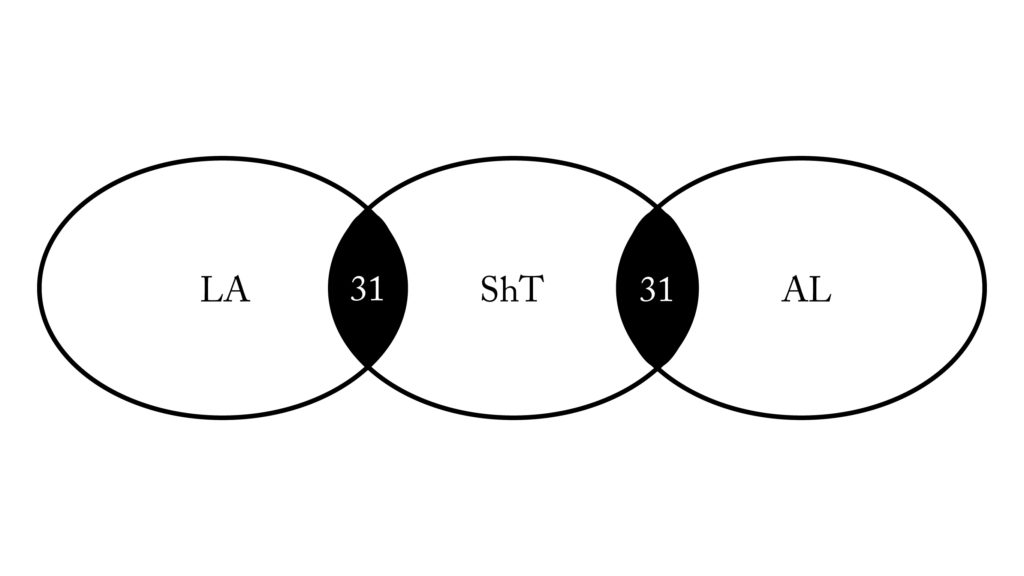
LA and AL both add to 31 by gematria. ShT also adds to 31 by way of the tarot cards these letters are attributed to. Sh or Shin is the Hebrew letter assigned to The Aeon, Atu XX, and T or Teth is assigned to Lust, Atu XI.
As someone recently pointed out to me, there is a tradition in the Golden Dawn, recorded in the Z1 document, of ST denoting an influence from Kether. ST is the Coptic letter ⲋ (“ⲥⲟⲟⲩ” or “soou”). Crowley continues this tradition by assigning this letter to Kether in 777, Column LI.
So by means of its association with 31 and Kether, ShT is identical with the (N)One at the foundation of Thelemic ontology and theology.
But ShT has an additional function. It also indicates the Beast and Babalon conjoined. It is a sexual formula. This sexual formula is indicated by how it is represented in Reguli on the human body and on the Tree of Life.
In the ritual, Aiwass, Therion, and Babalon are attributed to the cross paths of the Tree of Life: Daleth, Teth, and Pe respectively. The cross paths are important as they mediate between the Pillar of Severity and the Pillar of Mercy.
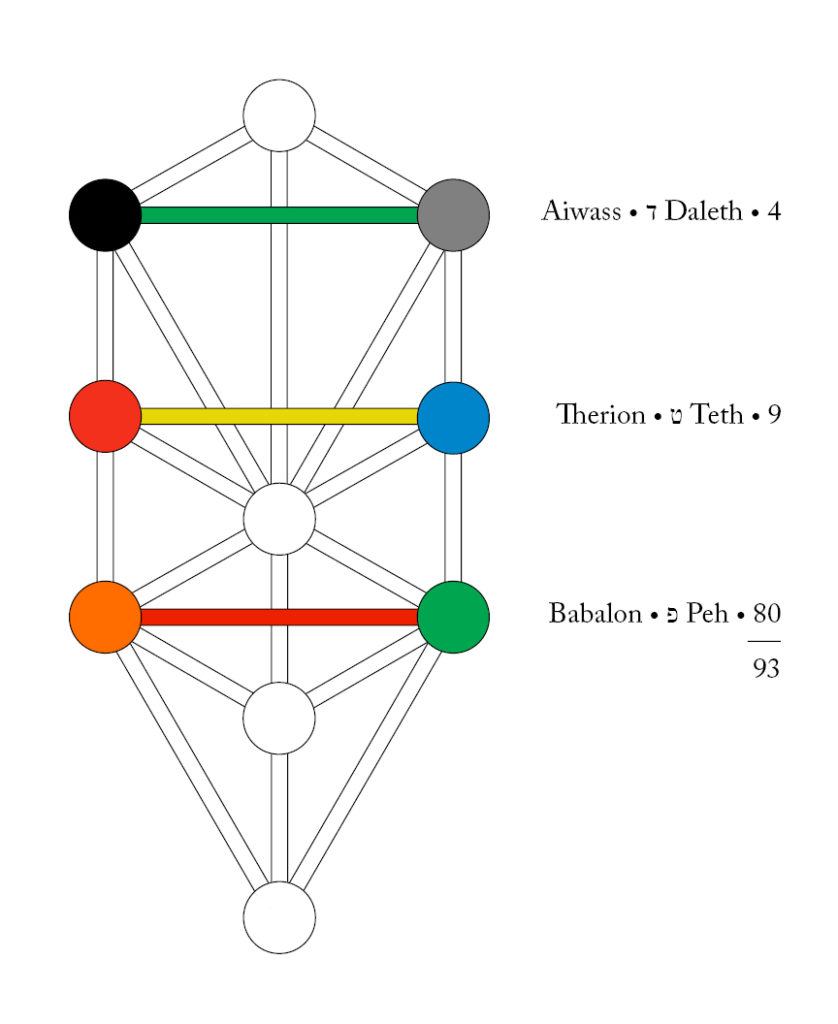
As taught in the Golden Dawn 4°=7□ ritual, the left pillar, the Pillar of Severity, is associated with the letter Shin, which is assigned to elemental fire, while the right pillar, the Pillar of Mercy, is Mem or elemental water. The Middle Pillar is then Aleph, which is elemental air. Fire is archetypally masculine, water feminine, and air androgyne.
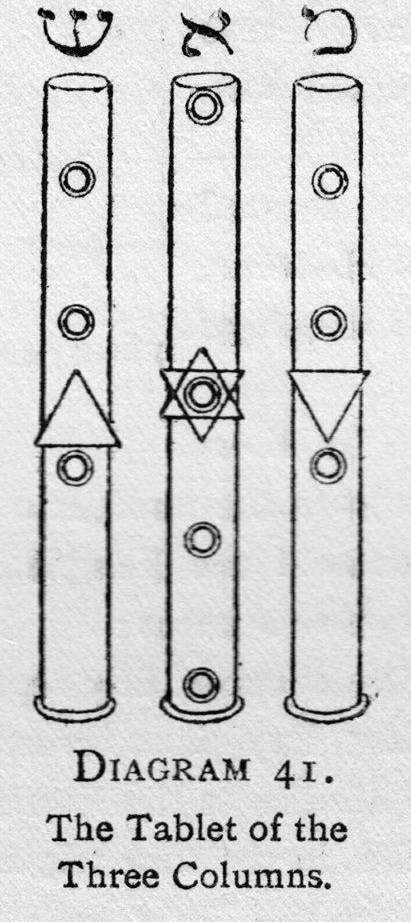
However, these sexual characteristics are not assigned to the pillars in a straightforward way. While the Pillar of Severity is fiery and masculine, the topmost sephira, Binah, is archetypally feminine. She is the supernal Mother. And opposite her, on the Pillar of Mercy, we find Chokmah, which is archetypally masculine, the supernal Father. They are “reflected” in Netzach (masculine-feminine) and Hod (feminine-masculine) respectively, as Kether is reflected in Tiphareth. This reflection occurs both horizontally across the Tree (Binah and Netzach and Chokmah and Hod are opposite each other across the Middle Pillar) and vertically down the Tree (they are opposite Tiphareth). The vertical and horizontal “components” of Liber V vel Reguli work with this double-reflection of sexual energy.
One can view this double-reflection of magical sexual polarity taking place on the Tree as a movement of energy down the Tree of Life from Kether into the subsequent Sephiroth along the paths. One androgyne current emerging from Kether, represented by the path of Aleph, becomes masculine upon reaching Chokmah. There it progresses down the tree along the archetypally masculine paths of Vau, Yod, Ayin, and Resh, into Yesod. In Yesod it is met by a complementary feminine path, originating with Beth’s entry into Binah, and progressing down the Tree along the paths of Cheth, Lamed, Nun, and Tzaddi.
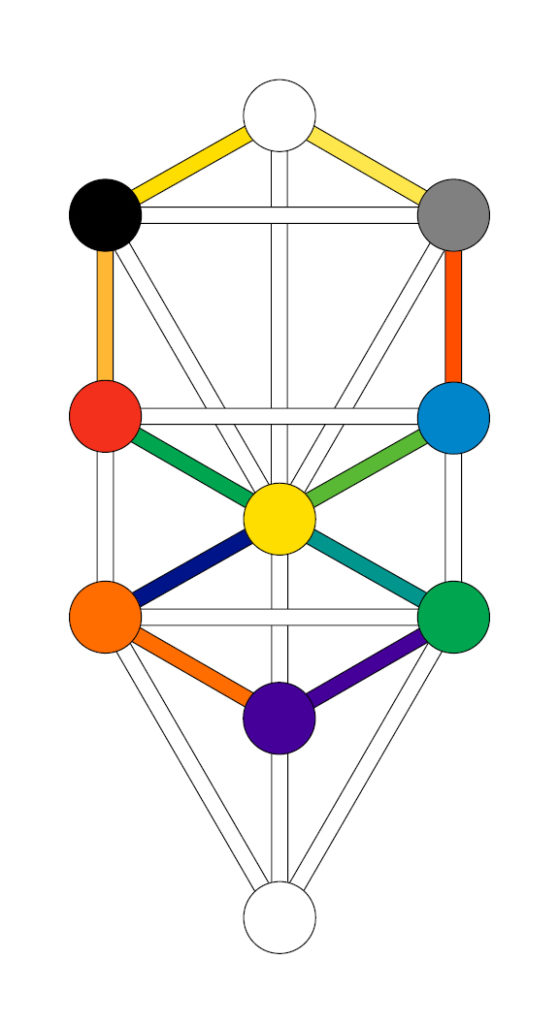
This exchange and “mixing in Yesod” is represented on the Art card, Atu XIV. Art is a hieroglyph of the path of Samekh, which links Yesod with Tiphareth. Here we see the Lion and the Eagle which have exchanged their colors as represented earlier on the Lovers card, Atu VI. If the paths on the Tree represent these essences or potencies, then they were exchanged at Tiphareth, a sphere which, among other things, is the site in which the Rose (Kteis) and Cross (phallus) are conjoined. The caldron is Yesod, which is linked with the sexual organs and the Muladhara cakra. We see spiritual air—presumably the Medicine of Metals—rising out of the caldron, represented by the arrow, as the Caput Mortuum (skull) drops to the bottom.
The cross paths are important to this process, because they are mediating the exchange of energies down the Tree. They are in a sense guiding and determining the separation and mixing of these sexual polarities. That these paths add up to 93 is significant. It tells us that the 93 magical current has something essential to do with the production of sexual polarity from out of androgyny and back again. It has to do with the movement of 0 to 2 (magick) and from 2 to 0 (mysticism), both as a personal spiritual journey and as a cosmological process. Aiwass, Therion, and Babalon are personages representing these governing principles.
For me personally, this is not simply theory. When I’m serving as Priest in the Gnostic Mass, I picture this exchange of energy occurring—moving down and wrapping around and joining mine and the Priestess’s hearts—at the consummation of the eucharist. We are linked energetically at the levels of mind (Daleth and Kether), heart (Teth and Tiphareth), and body (Peh and Yesod). The Tree of Life with the cross-paths can also be used as scaffolding for visualizations during sex magick workings.
If the horizontal component is governed by Aiwass, Therion, and Babalon, the vertical component is governed by Nuit, Ra-Hoor-Khuit, and Hadit. Nuit is associated with the Sahasrara cakra/Kether/the Three Negative Veils; Ra-Hoor-Khuit is linked specifically with the Anahata cakra and the paths of Teth, Yod, and Lamed (which add to 49), but also arguably with the entirety of the Tree in manifestation (hence Microprosopus); and Hadit is linked with the Muladhara cakra and Yesod and/or Malkuth (Crowley refers to this as the “seed” in his commentary).
The conjunction of Nuit and Hadit produces the godhead, Ra-Hoor-Khuit (or Heru-Ra-Ha, so as to include Hoor-paar-kraat). Hadit, as the consciousness or point of view of the individual, is implanted in Malkuth as a seed represented by Heh-final, the Virgin Daughter whose destiny is to be seated upon the Throne of the Mother (Binah). Crowley consistently related the three deities of the Book of the Law to the Tree of Life this way.
So one thing to take note of when attempting to understand LAShTAL is that it shares the same form or structure taken by these three personages in relation to the Tree of Life. You have two simple extremes mediated by a complex third thing sharing characteristics with both of the extremes. Indeed, the entire Tree of Life itself—or Ra-Hoor-Khuit—could be seen as a means of mediating between these oppositions.
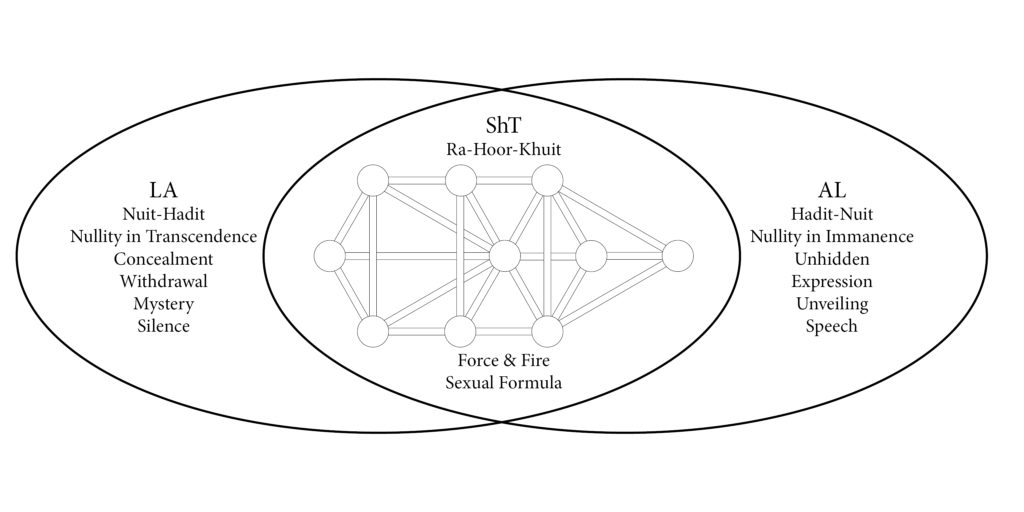
But how does the introduction of the horizontal component modify or inform this cosmological and theological process of the implantation, germination, and return of Hadit to the source?
The cross-paths enter into this as they are involved in the drawing of the Hexagram of Nature on the Tree of Life. Generally speaking, the hexagram is the symbol of the union of the individual with the divine, with the mirroring in the microcosm of the structure of the macrocosm. As such it is symbolic of the individual who has become divine. The cross-paths of Teth and Pe are involved in this hexagram—in fact are the only actual paths involved—as they form bases of the two interlocking triangles.
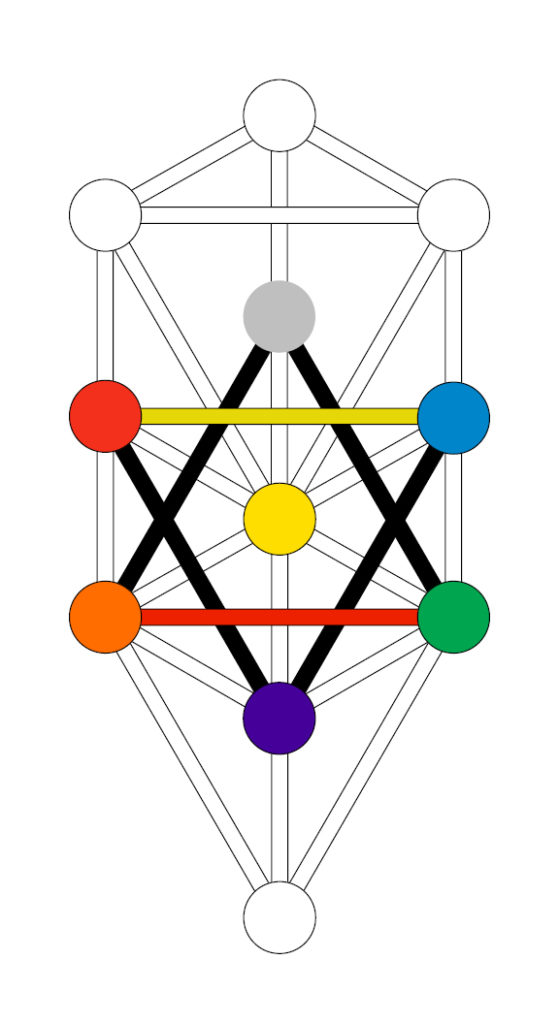
Typically the upward-pointing triangle represents fire and is therefore masculine, while the downward-pointing triangle is water and feminine. But a different connotation is suggested in Reguli where the base of the upward-pointing triangle is assigned to Babalon, and the base of the downward-pointing triangle is Therion. The polarities are reversed.
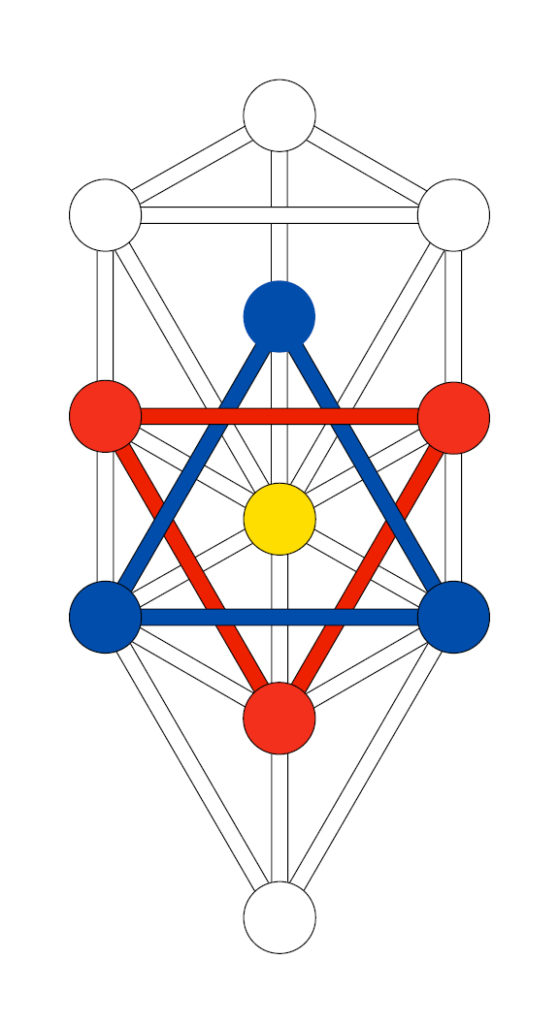
This suggests not so much the familiar Hexagram of Nature but rather the Magical Hexagram as described by Crowley in the Book of Lies, where fire points down and water up.
In the ordinary Hexagram, the Hexagram of nature, the red triangle is upwards, like fire, and the blue triangle downwards, like water. In the magical hexagram this is reversed; the descending red triangle is that of Horus, a sign specially revealed by him personally, at the Equinox of the Gods. (It is the flame desending upon the altar, and licking up the burnt offering.) The blue triangle represents the aspiration, since blue is the colour of devotion, and the triangle, kinetically considered, is the symbol of directed force.
Book of Lies, Chapter 69
Crowley explicitly associates force with the path of Teth in Reguli, as he associates fire with Shin. Hence ShT represents “force and fire”. In the context of the ritual, these triangles would interlock and interpenetrate around Tiphareth, representative of the Anahata cakra, Ra-Hoor-Khuit, and, as we saw earlier, Kteis-Phallus or the Rose-Cross.
As the upward-pointing blue triangle represents Babalon, the Mother, we could attribute the three Mother Letters (Aleph, Mem, and Shin) to its three points, as we might attribute the masculine trinity, IAO, to the three points of the downward-pointing red triangle. Their conjunction gives us the word AShIAVM, which has the same value as MShICh (Messiah) and NChSh (Nechesh, Serpent).
The Messiah or Anointed One affects the union between the individual and the divine. The Serpent in the Garden of Eden is the initiator of mankind into knowledge or gnosis. In Thelemic soteriology, this saving, initiating power is not one individual but rather the conjoining of two individuals, Therion (666) and Babalon (156). And the way in which this union between the divine and the individual is affected is sexual in nature.
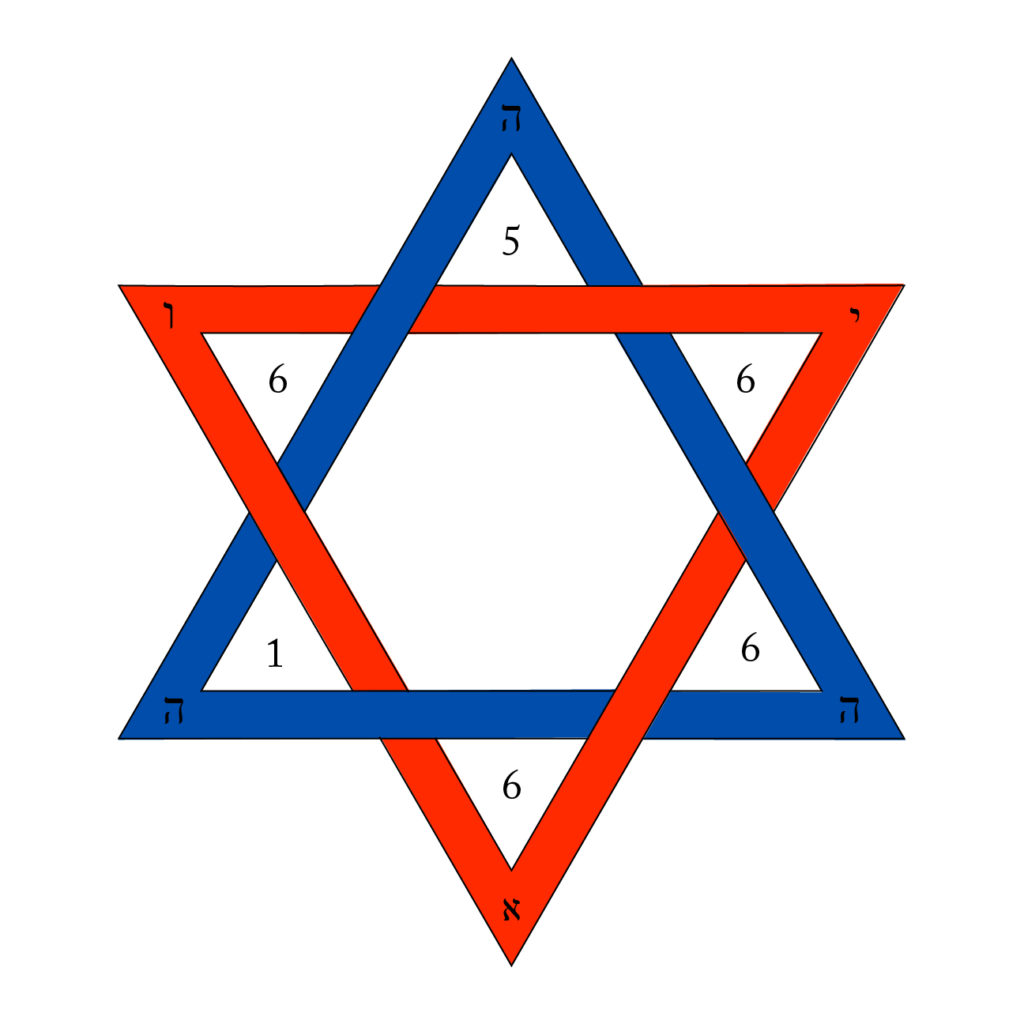
In this formula AShIAVM, the three mother letters are concealed by the letter Heh, giving us AHIHVH, the Great Name which is the conjunction of AHIH and IHVH.
AHIH is the godname of Kether. It represents existence in is most abstract quality or Macroprosopus. In the context of Reguli, it is LA, Nuit and Hadit conjoined.
IHVH represents god in manifestation or Microprosopus. It enumerates to 26 by gematria, which is 13 x 2. 13 is the enumeration of AChD or unity. IHVH therefore expresses unity (AL) by means of duality (ShT or Beast and Babalon conjoined). It is the way in which nullity expresses itself in manifestation or as the Tree of Life or 0=2.
Antonio Lau has come to a similar conclusion in his analysis of how the formula of AHIHVH relates to the Lesser Ritual of the Pentagram:
The conclusion would be that all the points of the Lesser Ritual of the Pentagram (32) on the whole create another Hexagram that symbolizes the Qabalistic Zero, radiating from the center of the Column and flooding the whole Circle with the Limitless Light of Ain Soph Aur. And the Hexagram is the formula of unifying opposites (positive and negative, active and passive, male and female), by the 0=2 Equation.
This sheds light on what it means that Reguli is meant to “invoke the energies of the Aeon of Horus.” The “first gesture” of the ritual—the drawing of the Elevenfold Seal—is depicting the unfolding process leading to the creation of the cosmos. It is also establishing the scaffolding—the cross-paths—that allow for the process of return. The “second gesture”—in which the Son raises the Daughter to the Throne of the Mother—is the familiar process of Tetragrammaton which, by means of sexual interaction between Son and Daughter, the process of return takes place. What Reguli adds to this conception is the idea that Nuit and Hadit (Daughter and Son) must become “sexually mature” as Babalon and Therion on their way of return.
AHIHVH is important for other aspects of Crowley’s spirituality. He relates it to the Lesser Ritual of the Pentagram. By means of the LRP it is indirectly connected with the production of the Medicine of Metals. The connection with the Medicine of Metals is made explicit through Crowley’s discussion of the production of the Eucharist of Six Elements in Magick in Theory and Practice Chapter 20. The production of this medicine is a secret guarded by the Sanctuary of the Gnosis of O.T.O. This formula is also the guiding structure behind Liber HHH, which describes some of the work of the Outer College of A∴A∴. At least one Thelemic author, J. Daniel Gunther, has made an extensive case for the AHIHVH formula being essential to a comprehension of Thelemic initiation in general. (See Initiation in the Aeon of the Child and The Angel and the Abyss.)
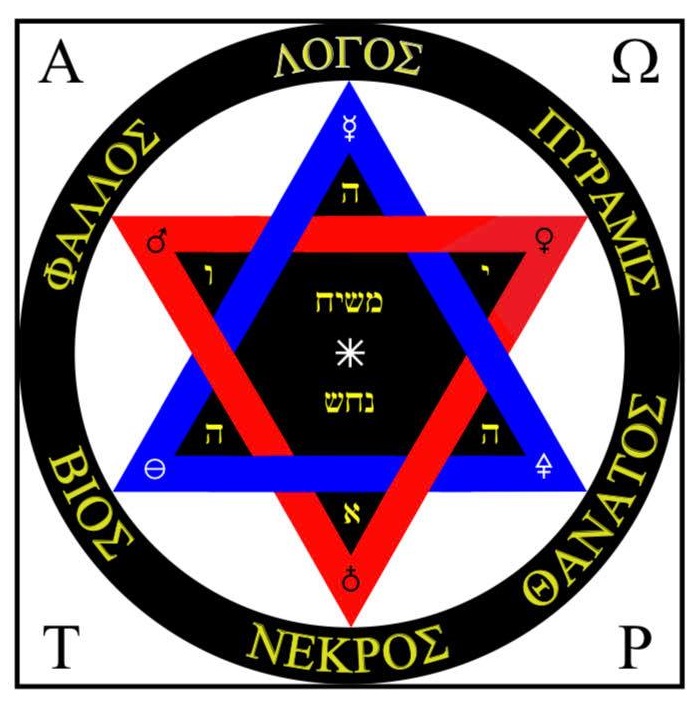
As I said in my recent talk on art and magick, when a magical formula is involved in so many disparate aspects of Crowley’s magick—especially when it illuminates mysteries of both A∴A∴ and O.T.O.—you can bet it is essential to an understanding of Thelemic spirituality generally. I hope to deal with this formula in greater depth in subsequent writings, exploring more fully its importance for Thelemic magick generally.
As for Reguli, my treatment of it here is not exhaustive. I have hardly dealt with the function of the cross-path of Daleth or how Aiwass figures into all of this. (There’s another hexagram that uses the path of Daleth as the base of a triangle.) I didn’t even touch on the elemental attributions of the deities/quarters, and I barely dealt with the significance of the cakras. But hopefully this shows the way in which Reguli is expressive of the underlying ontology and theology of Thelema and how the sex magick implicit in it relates to Crowley’s broader spiritual concern as expressed in the AHIHVH formula.
Balance and Imbalance on the Path
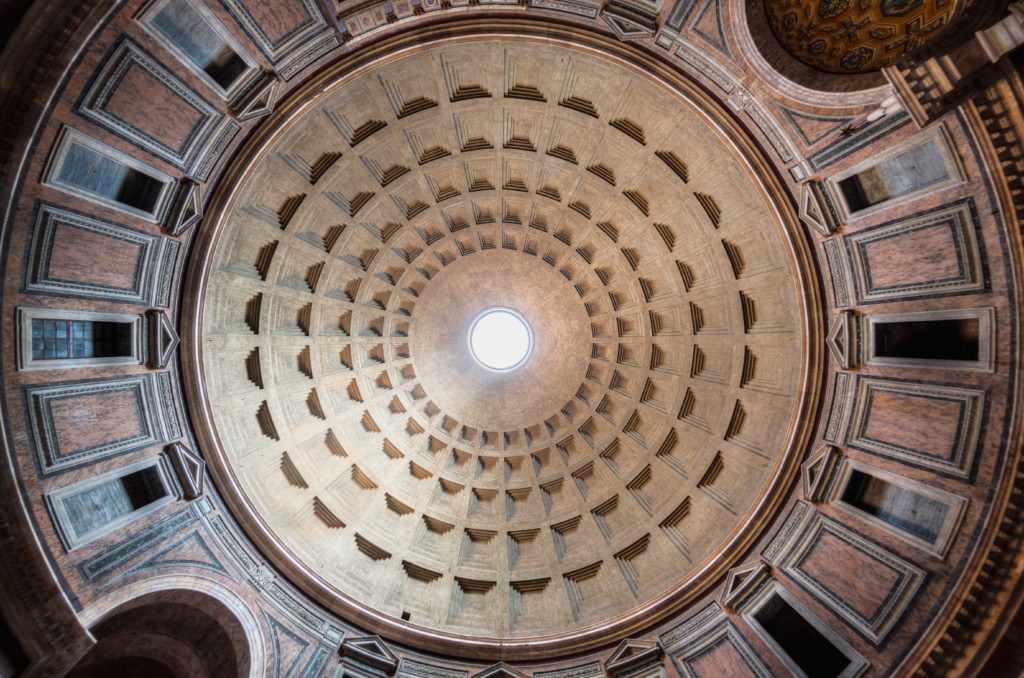
There’s this ancient temple in Rome called the Pantheon. It has a giant domed ceiling with a hole right in the center of it. I visited it in my 20s. I think “grand” is the right word to describe it. It’s not easy to capture in a photo.
When I think about the relationship between magick (especially theurgy) and mysticism, I recall what it was like looking up at the ceiling of the Pantheon from inside. I imagine the flower of the rose-cross painted on the ceiling, the opening in the middle being where the central cross would be. The multi-colored petals would be painted around the hole.
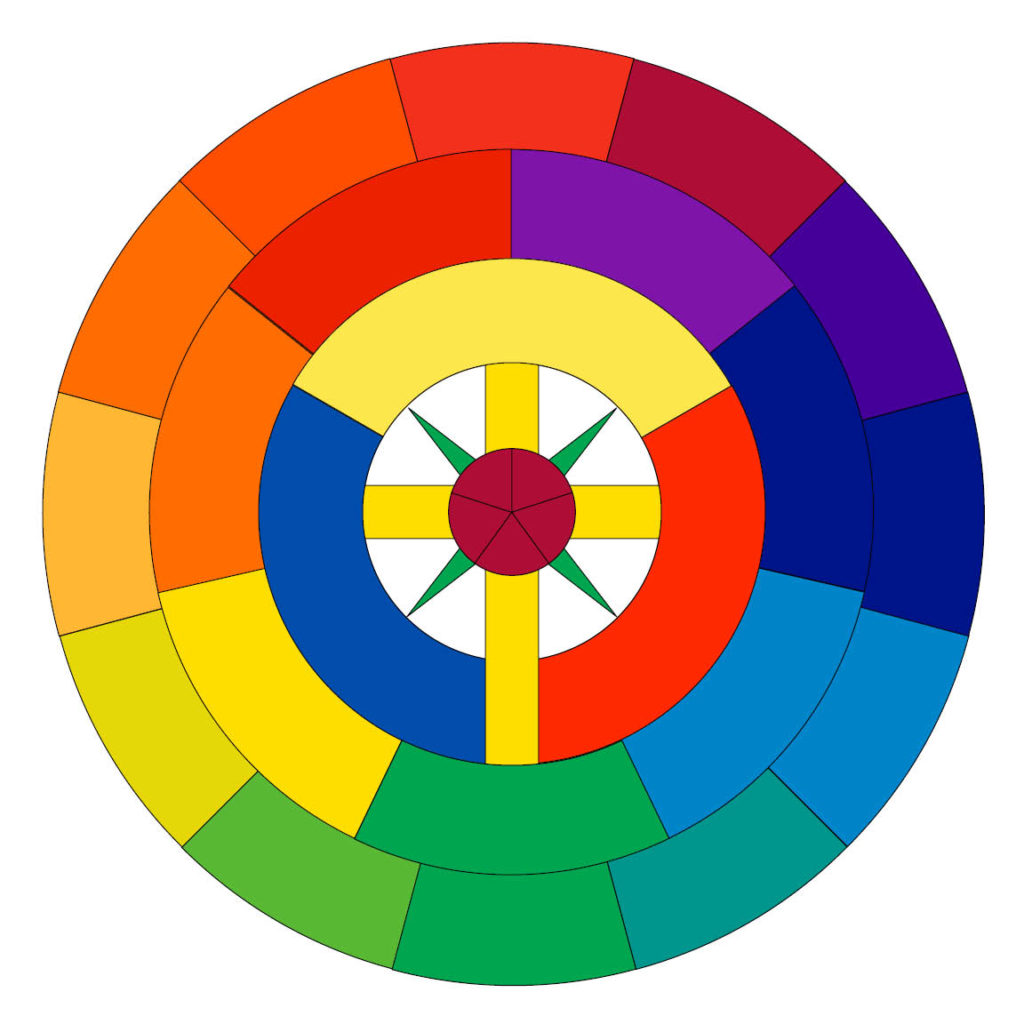
Whether you’re practicing theurgy or yoga, you’re aiming up in both cases. It’s just a question of how you aim. When you unite yourself with some particular god or goddess—or if you’re just working with some particular path—that’s aiming toward one of the petals off to the side of the central opening. But yoga is like aiming in a direct, vertical line through the hole in the roof.
Of course that’s exactly how Crowley thought of Knowledge and Conversation of the Holy Guardian Angel as well. The Holy Guardian Angel is on the middle pillar of the Tree of Life.
The magician devotes himself entirely to the invocation of a God, and as soon as his balance approaches Perfection he ceases to invoke any partial God; only that God vertically above him is in his path. And so a man who perhaps took up magic merely with the idea of acquiring knowledge, love, or wealth, finds himself irrevocably committed to the performance of the great work.
Magick in Theory and Practice, Chapter 15
I shoot up vertically like an arrow, and become that Above. But it is death, and the flame of the pyre. Ascend in the flame of the pyre, O my soul! Thy God is like the cold emptiness of the utmost heaven, into which thou radiatest thy little light. When Thou shall know me, O empty God, my flame shall utterly expire in Thy great N. O. X.
Liber VII, I.37-40
The O.T.O. IX° working is also a middle pillar working. It is attributed to the path of Samekh, the path uniting the Sun (Tiphareth) with the Moon (Yesod). Its hieroglyph depicts a Lion and an Eagle exchanging their essences into a cauldron. The Caput Mortuum drops to the bottom of the cauldron as spiritual air (Aleph, Baphomet) rises. This rising spiritual current is the “Rashith-ha-Gilgalim of the new Universe created of the Quintessence of the Substance of the Unity of the Angel and the Adept, expressed therefrom by virtue of ‘love under will’ at the moment of Rapture.” (Commentary on LXV V.1) This is the spiritual essence unlocked from the Eucharist of One Element, the Medicine of Metals. It is like a cosmic stem cell which can be molded into any physically possible state of affairs by the magician.
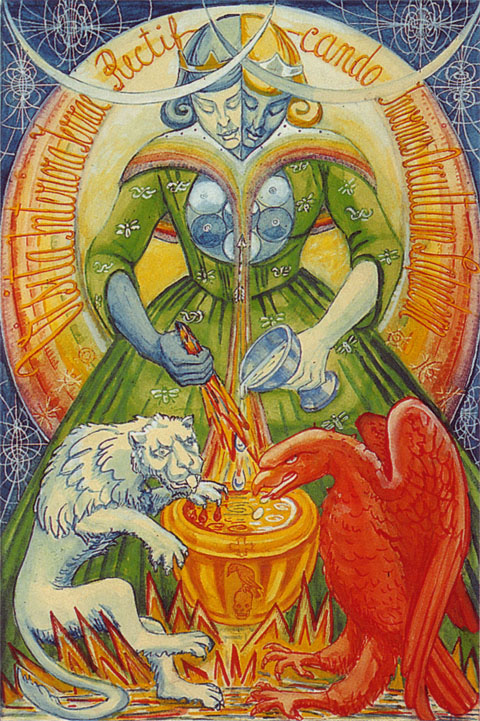
In other words this issue of working the middle pillar applies both to the Knowledge and Conversation of the Holy Guardian Angel as well as the IX° magick. It applies to the mysteries of both A∴A∴ and O.T.O.
This mystery is represented analogously in the Gnostic Mass. Here it is depicted using a eucharist of two elements rather than one. The Priestess is like the Angel of the Priest, and the “moment of rapture” is symbolized when they cry HRILIU.
Another way to put it is that in the case of yoga, one aspires up the middle pillar, but in this particular kind of magick, one manifests a current down the middle pillar (into the organs of generation, which are represented on the Tree of Life by Yesod). Generally speaking, magick is a movement of energy “down the Tree”. The impulse originates with the Will in Chokmah and is given form on the astral at Yesod before manifesting in Malkuth. Yoga, theurgy, and path workings tend to be ascensions “up the Tree”. Both operations (yoga and magick) require mastery of the subtle energetic currents represented by the entire Tree of Life, though.
It’s a commonplace to talk up “balance” in relation to Crowley and Thelema, but it really is an essential theme. “Balance” will mean different things to you at different points of your spiritual development. There’s balance of the elements within your conscious experience. There’s a balance point or borderline between conscious and unconscious which has to be worked with more or less interminably. There’s contrasexual balance points.
What happens typically is that you experience a “calling” into some terra incognita. This might be an entirely new calling, or it might be some perennial difficulty in your life. But it will draw out what Jung called a complex. The easiest way to describe a complex is that you just don’t feel like yourself anymore. You feel like you’ve temporarily become a different person. If you are usually self-controlled, you’re suddenly impulsive. If you’re usually strong, you’re suddenly clingy and weak. If you’re usually kind, you’re suddenly sadistic. And then you have to work with that imbalance in order to get yourself back to a place of balance.
God is above sex; and therefore neither man nor woman as such can be said fully to understand, much less to represent, God. It is therefore incumbent on the male magician to cultivate those female virtues in which he is deficient, and this task he must of course accomplish without in any way impairing his virility. It will then be lawful for a magician to invoke Isis, and identify himself with her; if he fail to do this, his apprehension of the Universe when he attains Samadhi will lack the conception of maternity.
Magick in Theory and Practice, Chapter 1
In my opinion, Crowley’s description of this process here is perfunctory, even blithe.
In any case, there’s really no formula for this. I’m not even going to try to offer “helpful hints” on it. But generally speaking, that’s the work of magick or going “off-center” as I described above.
Between Rationalism and Fanaticism
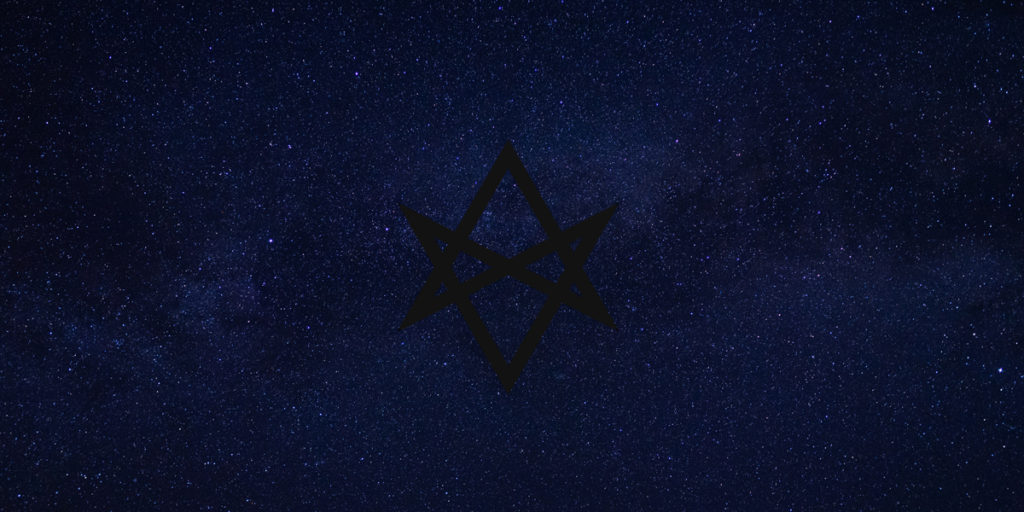
In my opinion what makes Thelema distinctive is not the occultism, not the ontology, not the ethics, not the individualism. It’s that he took the western occult tradition with its God as a creative artist and inflected it through a Nietzschean understanding of life.
Renaissance occultism is based upon a view of the cosmos where everything is ordered into spheres or levels with Earth as the focus. Natural magic is about drawing power or spiritus down from higher spheres into lower ones. “Cabalistic” magic is about ascending to superluminary spheres and mastering the angelic forces there—which tips over very easily into mysticism, as it does in Thelema. In short it’s based on a hierarchical, anthropocentric view of the universe as a kind of container focused on human affairs, and the container is overall not that large.
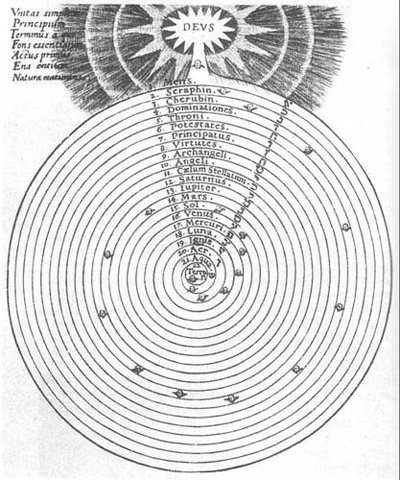
This view was largely replaced by the natural philosophy in the 17th and 18th centuries. According to this new view, the universe does not behave according to purposes but rather mechanisms. There are no “pulls” in the universe, only “pushes”. And the universe in which these abstract mathematical laws operate is vast enough to overwhelm the imagination and the human perspective all together. The picture of the universe generated by this natural philosophy ultimately left up in the air the place of humans in it. And with this disenchanted view of nature came a challenge to both religion and magic.
Rather than recoiling from this picture of nature into a kind of reenchanted fantasy about life, Crowley instead embraces it. The sheer enormity of the cosmos is one of the premises of Crowley’s view of reality, embodied in the goddess Nuit. The pure mathematical view of reality is not rejected either but embraced. Mathematics was part of occultism going back at least to Pico, but Crowley really makes it one of the main themes of his spirituality. So in other words rather than trying to hide from the implications of modernism, Crowley leans into them.
And he understands the fundamental spiritual problem in a very modernist way. The problem we face is not suffering, and it’s not ethics. These are pre-modern or early modern ways of looking at the problem. No, the main problem is meaning. It’s the senselessness of the world. Crowley was motivated by this experience of senselessness at least since he was a student at Cambridge, and he writes about it at least as late as Little Essays Toward Truth.
What then determines Tiphareth, the Human Will, to aspire to comprehend Neschamah, to submit itself to the divine Will of Chiah?
Aleister Crowley, Little Essays toward Truth, “Man”
Nothing but the realisation, born sooner or later of agonising experience, that its whole relation through Ruach and Nephesch with Matter, i.e., with the Universe, is, and must be, only painful. The senselessness of the whole procedure sickens it. It begins to seek for some menstruum in which the Universe may become intelligible, useful and enjoyable. In Qabalistic language, it aspires to Neschamah.
The way he understands a possible solution to senselessness is very modernist as well. The solution cannot be sought in reason. Reason operates according to the principle of sufficient reason, i.e., for any proposition F, there must be a ground G for it, or for any event B, there must be a sufficient explanation A. Putting the principle of sufficient reason at the center of human relating to the world is what generated the picture of a senseless, purely mechanical world in the first place. Therefore, reason—specifically the application of the principle of sufficient reason—must be limited, but to limit reason it must be transcended.
But—the transcendence of reason cannot interfere with the legitimate operation of reason within its own domain. Crowley is not looking to reenchant nature in some naive way. He accepts the findings of the scientific view of reality and even holds them to be axiomatic for his spirituality. Nor can the transcendence of reason be a mere animalistic “overcoming” of reason. One cannot simply will oneself to be irrational, for instance. Both of these avenues would represent a kind of fanaticism.
So Crowley has to manuever somehow between the Scylla of rationalism on the one hand and the Charybdis of dogmatism or fanaticism on the other.
This is a very modernist—specifically German Idealist—way of looking at things. When a person with a background in the philosophy of Kant, Fichte, Hegel, and Nietzsche hears Crowley talking about transcending “because,” they’re hearing a tune they could hum in their sleep.
And Crowley’s proposed solution to this problem is will. Will transcends reason. You cannot ask “why” of will. In and of itself it prevents the questioning but instead gives orders. It’s authoritative. This is how he avoids rationalism.
But will also represents the “true” self of the individual. It is not a mere replacement for Jehovah. It is not a projection of the law of the father. Nor is it exactly bodily or animal instinct. This is how Crowley avoids fanaticism.
The Secret of the Holy Graal
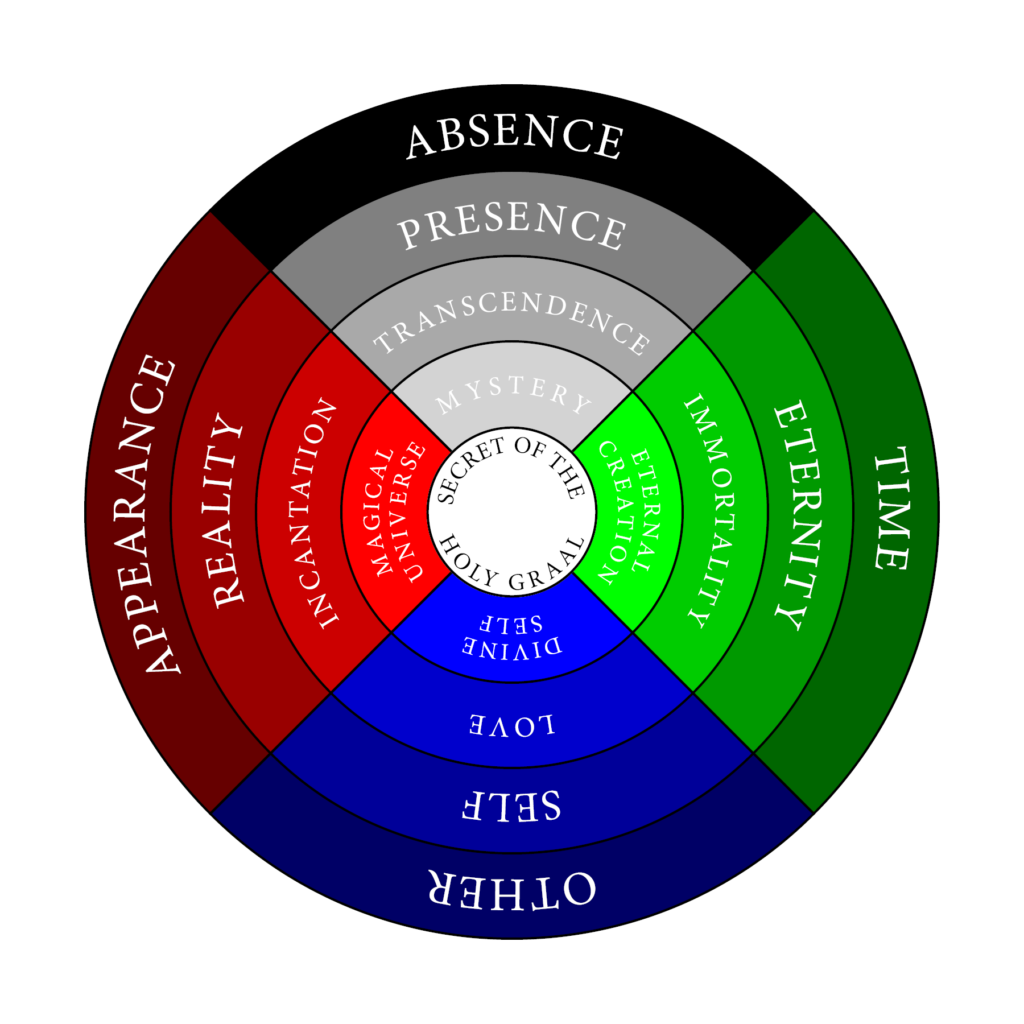
Not sure if I ever offered an explanation of my intention in making this.
This was meant to visualize some insights I had while listening to Alan Chapman’s Magia Teachings and reading Peter Kingsley’s book on Carl Jung, Catafalque, last summer.
The outer circle represents forms of absence. The flow of time is the absence of presence or the now. The other is the absence of self or self-subsistence. Appearance is the absence of reality.
Opposed to absence is the second circle of presence. Eternity is opposed to time by standing outside of it. It is the eternal present or the eternal now. Self is opposed to other. It is that which subsists, that which possesses itself. Reality is opposed to mere appearance by being the opposite of illusion.
Philosophy and spirituality aim to overcome absence and to achieve presence. They aim at timeless truth, the One Self or One Itself, the reality that lies behind the mere flow of appearances.
But overcoming absence is merely the first stage of the process. The next level of insight requires one to find absence in presence: eternity in the here and now, self in other and other in self, reality in appearance. Once both presence and absence are found in one another, their duality is transcended.
The union of time and eternity is immortality.
The union of self and other is love.
The union of appearance and reality is incantation or magical speech.
Aleister Crowley grasps this non-duality of duality and non-duality through the idea of 0=2. But 0=2 is not the mystery itself but rather the gateway to the mystery. 0=2 is the portal through which Thelemic spirituality opens on to the subterranean current of mystery underlying human transcendence as such.
Now we encounter eternal creation as the characteristic activity of the immortal God.
We find the divine self as the the loving comportment of All with Itself.
And we find the magical universe as the self-speaking totality.
Beyond even that mystery there is the mixing bowl or kratēr in which All is manifest: the divine individual, the sōtēr or the Holy Graal.
Two Essential Patterns in Crowley’s Spirituality
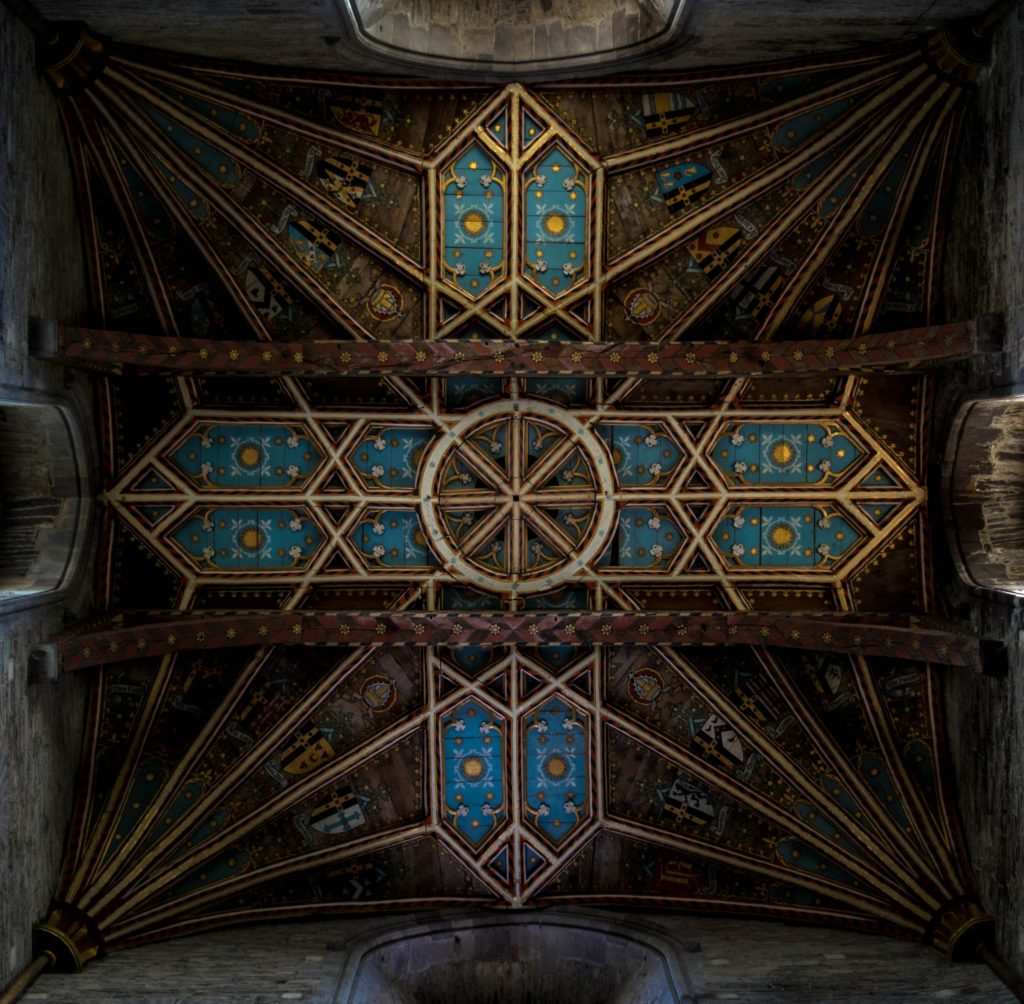
Two of the most important patterns in Crowley’s spirituality are the relationship between speech and silence and the relationship between the word and life and death.
You see the speech-silence pattern crop up everywhere. The Book of the Law itself is delivered by Aiwass, who announces himself as the minister of Hoor-Paar-Kraat, the god of silence. So the Book of the Law could be understood as the speech of the god of silence.
The god of silence is absent, unmanifest. Any attempt to objectify the god of silence inevitably fails. So the issue of speech and silence is simultaneously the issue of presence versus absence. Absence can only be manifest through presence by means of various detours or blinds—basically illusions. Magic deals principally in illusions, the magician being a Master of Illusions. This is why all the powers of the magician revolve around silence.
Absence is also worked with through Crowley’s pseudonyms: Perdurabo, To Mega Therion, V.V.V.V.V., Chioa Khan, etc. (I’ve never actually seen anyone attempt this analysis for some reason…)
The speech-silence pattern shows up in the Mass. “Silence” is indicated at two crucial points in the script. Also, if you’ve read any of my stuff on the Mass, I’ve indicated how essential Hoor-paar-kraat is to that ritual. The Mass itself is a ceremony of implantation of the god of silence into the soil of the Earth.
The drama of the Mass moves from the silence of the tomb, out into manifestation, and then back into the silence of the tomb.
AUMGN—the formula most often vibrated through the Mass—is itself a formula representing the movement of the silent seed into manifest speech and back out into non-existence.
The neophyte formula of A∴A∴ encapsulates exactly the same idea in slightly different form. In Pyramidos, it is described as the path of HUA or IAΩ—in other words of the Holy Guardian Angel itself.
The Man of Earth degrees form a cycle which expresses the same idea. In the Minerval degree, the candidate manifests out of silence or nothingness, is brought into manifestation in the 1st and 2nd degrees, passes out of existence in the 3rd, and passes back into silence or nothingness as a Perfect Initiate.
If you’ve read my stuff, you know I think the MoE candidate is actually the HGA for pretty much exactly this reason. If you’ve read my stuff on the Mass, you know I think it involves the HGA in exactly this way.
“Oh so what? You think everything Crowley ever did was about the HGA, huh?”
How many times did he himself say that? He couldn’t have been kidding all those times.
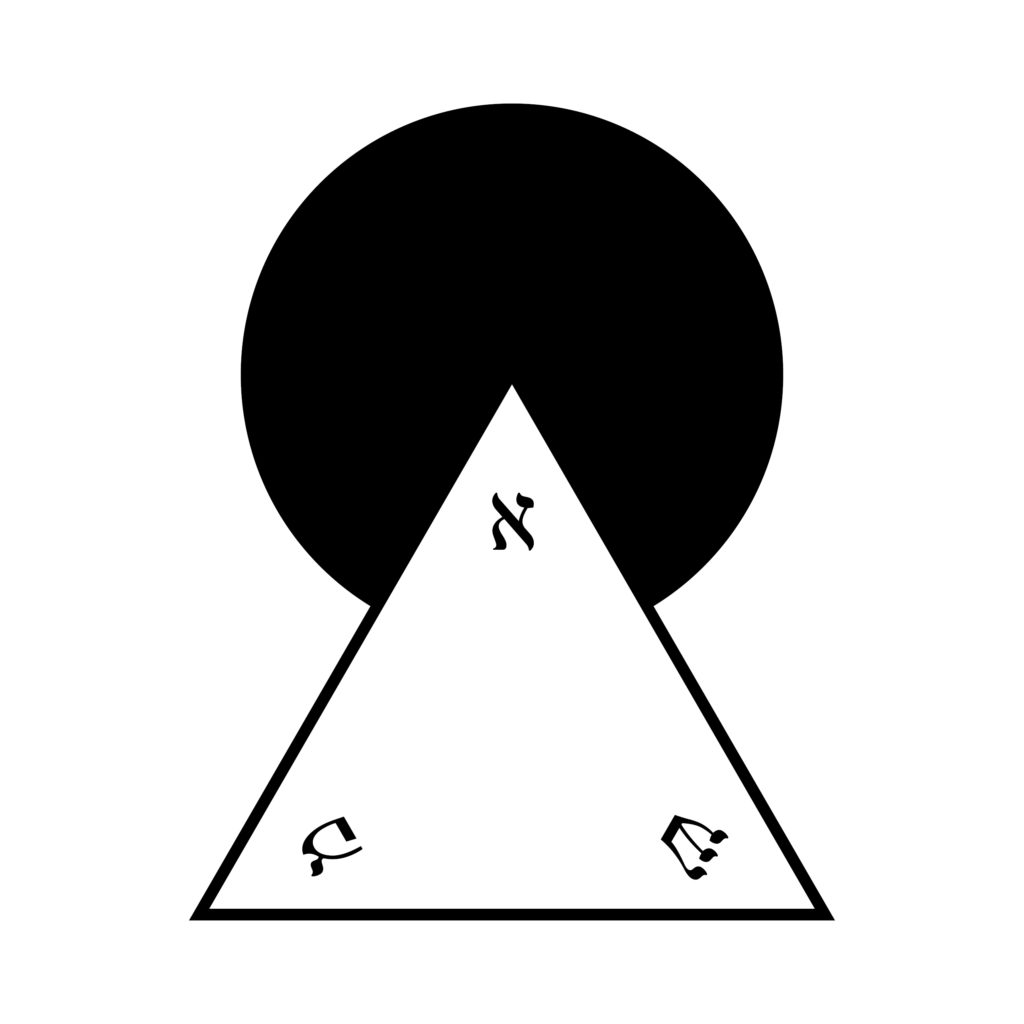
And then the other pattern has to do with the word—which is the HGA in manifestation—as it relates to life and death.
So the first thing to notice is that the word uses life and death to manifest itself down the generations. It’s how it gets spoken in the first place.
So the word in the macrocosmic sense is the Sun and basically all the things the Sun represents. In the Mass, we refer to the Sun as ON, which represents the Beast 666 who is also the Logos (word) of the current Aeon. And since most magical formulae represent not only a thing but also a process of attainment, ON also represents two paths of deification of the individual, one corresponding with Ayin, the other with Nun. (I’ve written about this elsewhere.)
But the word in the microcosmic sense—where it relates directly to life and death—is the phallus. This is the word utilizing the process of life and death or incarnation or becoming or suffering or what have you in order to manifest itself. This is the 5th collect of the Mass. This is the Anthem. This is the production of the seed which goes into the soil which becomes Baphomet. It’s the whole magic of the Mass, really: manifestation of the macrocosm in the microcosm.
Now when it manifests, it also transcends those conditions or reveals itself as transcending those conditions. Hence, Baphomet “destroys the destroyer”. This is the redemptive aspect of the word. This is why you would want to hear the word. This is why you would want to know God or to experience Knowledge and Conversation. It’s because it’s that within you which is using you or using your conditioned existence in order to be. It’s that for the sake of which all this is happening. It’s the impersonal vibration left over at the end of AUMGN from which existence will once again spring forth.
You find the same issue at work in the 3rd degree of M∴M∴M∴.
You see it in the IAO formula.
You see it in the Neophyte ritual of A∴A∴.
So if you ever find yourself lost in the weeds of Crowley’s writings, these are the two patterns I would try to focus on. One pattern has to do with how speech and silence relate. This is the life-cycle of the Word, the Logos, the HGA. The other pattern has to do with the life of the Word. This is how the Word uses life-death to manifest itself and how in the process it redeems becoming.


